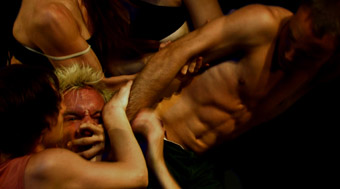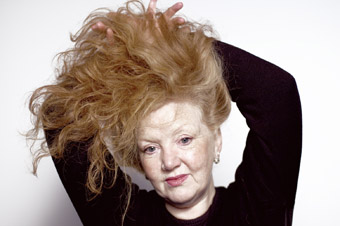 |
Raft of Medusa |
During her three year tenure, Moyse steered the Manchester-based event into a new homebase at the city’s arthouse cinema, in addition to working partnerships with a range of regional, national and international organisations, this year including Northwest-based Comma Pres, Sadler’s Wells in London (home of the curatorially innovative dance/film series Live Screen) and a globe-spanning network of screendance sister festivals.
For 2009, an ongoing commitment to non-traditional, city-wide access points variously included Shelly Love’s newly commissioned exploration of historical portraiture, created for public screen viewing; downloadable podcasts and mobile phone content and Eloi Maduell’s kaleidoscopically interactive pLayModes installation at the Lowry. An additional gallery-set program featured Lutz Gregor’s Raft of Medusa (2008), a contemporary reinterpretation of the Géricault painting. Sergei Eisenstein made reference to “the eye taking a walk” within the process of graphic composition. Gregor’s use of high definition, chiaroscuro-lit, ultra-slow motion leads the viewing eye at leisure along sightlines created between subtly shifting figural groupings.
Maya Deren famously exhorted filmmakers to avoid “trying to invent a plot that moves” and instead to “use the movement of wind, or water...as a poem might celebrate these.” Hilary Goodall’s adjacently sited floor and ceiling projections Earthmoves 1+2 (2008), thus threaded together naturally occurring movement patterns of English summer, as traceries of twigs and branches, surface water currents, and profusion of blossom sat amid viewing friendly deckchairs, picnic hamper and daisy speckled astroturf.
A series of discussion forums at the Cornerhouse Cinema opened with recent work from established British artists Alex Reuben and Becky Edmunds, created during respective residencies in Brazil and Swedish Lapland, with both exploring non-linear narrative forms. Later, Ian Patterson’s speculation on the narrative potential of virtual environments and Paolo Cirio on the genre of recombinant fiction—meshing factually based content with conventions imported from gaming and the blogosphere—represented the festival’s continued slant towards new media-influenced input.
A specially curated, afternoon set edition of Brighton-based South East Dance Agency’s Dance For Camera Nights featured current agency fellowship recipient Lucy Cash enlisting her audience in an improvised Q&A for a collectively imagined film project. She then outlined her own creative approach as the parallel multi-branchings of “quantum storytelling.” A one-day version of the highly influential Open Source Video Dance Forum, led by Simon Fildes at the festival’s end, catalysed grassroots-upwards dialogue, drawing together such historically disparate approaches to movement and narrativity as Maya Deren’s theory of vertical progression and web 2.0 facilitation.
Festival debuts for innovative strands included Max Hatler and Noriko Okaku’s laptop-enabled live performance of intertwined electronic audio and fleeting, fragmented visuals, shown at The Green Room in association with Liverpool-based festival of alternative media, Abandon Normal Devices. A program curated by poetry publishers Comma Press screened within the airily atmospheric surroundings of the Cervantes Institute, showcasing an inventive marriage of non-linear narrative and visual collage, including Manchester-based filmmaker Kate Jessop’s subtle augmentation of Simon Armitage’s rhythmic cadences, On Miles Platting Station (2008), as slate-grey palette of archive commuter footage and red/amber/green rotation of isolated signal lights followed giant, yellow-centred daisies, gently sprouting between long disused sleepers.
From a newly introduced program for younger audiences, Charlotte Dolman’s highly accomplished What’s In Store (2008) created an appealingly anarchic, convincingly self-contained stop-motion world of self-willed cleaning products in broom cupboard hi-jinx. Julie Angel foregrounded the subjective experience of a young, male parkour practitioner in Feedback Loop (2008) as spatially disorienting, body-cam footage of feet and hands reached for slanted concrete, brick and metal, before alighting in a rectangular-framed oasis of green.
In the first of two historically relevant programming slots, a BFI selected cross section of Czeck filmmaker and animator Jan Svankmajer’s output spanned three post-war decades of surrealist influenced work, while Lotte Reiniger’s The Adventures of Prince Achmed, from 1926, set intricate, cursively stylised hand-cut paper silhouettes of heroes, princesses and hydra-headed creatures against vivid washes of background colour.
 |
Requiem for the Redhead? |
Aaron Epstein and Daniel Stedman’s The Moth and the Firefly (2008) provided a witty masterclass in narrative economy, offsetting insect movement trajectory against silent film style intertitles. Contrastingly, Jeff Chiba Stearn’s Yellow Sticky Notes (2007) achieved a virtuosic feat of autobiographical animation, mixing high profile world events—as jumping flour sacks and waving blades of grass shimmered, swirled and transformed into rabbit-eared twin towers and a water-spewing tsunami giant—with the ephemeral jottings of personal ‘to do’ lists scribbled on post-it pads. The title of second-time filmmaker Mark Jones’ delicately nuanced documentary, Taken By The Air (2008), reflected both the allure of weightless inversion and its ever present threat of fatality. Beginning with the rhythmic patterning of young feet on stone stairways, a sophisticated balance of photography, DV footage and voice-over contrasted arc lights and feathered costumes with metal harness clamps and nylon rope, as fragments of monologue, given new meaning by cumulative weighting of context, repeated at the film’s end.
A continuing festival focus on global partnership saw carte blanche extend across three continents, as Barcelona-based NU2’s programme of Spanish-made work, introduced by director Núria Font, opened with Aitor Echeverria’s rhythmically inventive linkage of isolated body parts in Aprop (2006), and included Isabel Rocamora’s characteristic measured pacing and studied painterly aesthetic, counterbalanced by a less evenly worked narrative thread, in Promise of Fallen TIme (2008).
A series of African-themed films, curated and presented for Moves by Jeannette Ginslov, featured Guy Spiller’s ethereal, hallucinatory graphics, illustrating the transformative properties of ancient firelit ritual in Trance Dance (2007), and the outsider perspective of Sergio Cruz’ colour and heat drenched fusion of Mozambican music-making, movement and run-down urban environment in Exotica (2009).
Completing the trilogy, a selection from Australia’s ReelDance archive included Madeleine Hetherton and Rowan Marchingo’s luminously photographed portrayal of triangular family tensions in Shadow Play (2007), while a second viewing of Gideon Obrazanek and Edwina Throsby’s deceptively easy-watch movement palette of finger-pointing, head-shaking and bum wiggles in Dance Like Your Old Man (2007)—previously screened in Britain as part of Brighton-based Dance for Camera programming—pinpointed subtle shifts into darker layers of emotional shading as narrated episodes of relationship breakdown within the complex father-daughter bond translate visually into unsettling slow motion and extreme close-up.
Dance filmmaker Douglas Rosenberg has commented on the often precarious positioning of fellow artists, stating that ‘dance itself is a marginal artform and certainly dance film and video makers must be considered on the margins of the margin.” Moves09 presented an appealing model of international networking and co-operation for artists, audiences and festivals, at a pivotal time for the artform’s development. As boundaries expand to include medium-specific composition, an international era of screendance 2.0 appears to be with us.
Moves09, Cornerhouse and other venues, Manchester, April 23-28
RealTime issue #91 June-July 2009 pg. 29
© Chirstinn Whyte; for permission to reproduce apply to [email protected]








 back
back